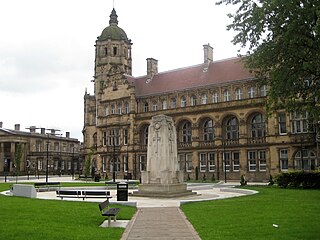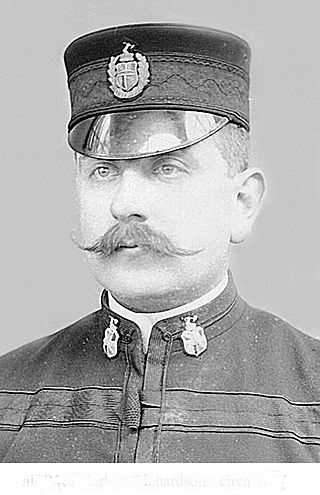
Wakefield is a cathedral city in West Yorkshire, England located on the River Calder. The city had a population of 109,766 in the 2021 census, up from 99,251 in the 2011 census. The city is the administrative centre of the wider metropolitan district, which had a 2021 population of 353,368, the 23rd most populous district in England. It is part of the West Yorkshire Built-up Area and the Yorkshire and The Humber region.

The City of Glasgow Police or Glasgow City Police was the police covering the city and royal burgh of Glasgow, from 1800 to 1893, and the county of city of Glasgow, from 1893 to 1975. In the 17th century, Scottish cities used to hire watchmen to guard the streets at night, augmenting a force of unpaid citizen constables. On 30 June 1800 the authorities of Glasgow successfully petitioned the British Government to pass the Glasgow Police Act establishing the City of Glasgow Police. It served Glasgow from 1800 to 1975, when it was amalgamated into Strathclyde Police.

Sandal and Agbrigg railway station serves the Wakefield suburbs of Sandal and Agbrigg in West Yorkshire, England. It lies on the Wakefield Line and is operated by Northern.

Warwickshire Police is the territorial police force responsible for policing Warwickshire in England. It is the second smallest territorial police force in England and Wales after the City of London Police, with only 823 regular officers as of September 2017. The resident population of the force area is 554,002.

Durham Constabulary is the territorial police force responsible for policing the council areas of County Durham and Darlington in North East England. It does not cover all of the ceremonial or historic area of Durham, parts of which are covered by the neighbouring forces of Cleveland Police and Northumbria Police. The other neighbouring forces are Cumbria Constabulary to the west and North Yorkshire Police to the south.

West Yorkshire Police is the territorial police force responsible for policing the metropolitan county of West Yorkshire, England. It is the fourth largest territorial police force in England and Wales by number of officers.

South Yorkshire Police (SYP) is the territorial police force responsible for policing South Yorkshire in England. The force is led by Chief Constable Lauren Poultney. Oversight is conducted by Police and Crime Commissioner Alan Billings.

North Yorkshire Police is the territorial police force covering the unitary authorities of North Yorkshire and the City of York in northern England. As of September 2018 the force had a strength of 1,357 police officers, 127 special constables, 192 PCSOs and 1,072 police staff. Of the 43 territorial police forces in England and Wales, the force has the 3rd largest geographic area of responsibility whilst being the 15th smallest force in terms of police officer numbers.

The West Yorkshire Constabulary (WYC) was, from 1968 to 1974, the statutory police force for the West Riding of Yorkshire, in northern England.
The Bradford City Police was the municipal police force of the city of Bradford,Yorkshire, England, UK.
Barnsley Borough Police was the police force operating in county borough of Barnsley, England until 1 October 1968. The force was merged with other forces in 1968 to form the West Yorkshire Constabulary. The area passed to the South Yorkshire Police in 1974.

The West Riding and Grimsby Railway was a railway company that promoted a line between Wakefield and Doncaster, in Yorkshire, England. There was also a branch line connection from Adwick le Street to Stainforth, which gave access towards Grimsby. The company was promoted independently, but it was sponsored by the Manchester, Sheffield and Lincolnshire Railway and the Great Northern Railway, and became jointly owned by them.

The Police Act 1964 was an Act of the Parliament of the United Kingdom that updated the legislation governing police forces in England and Wales, constituted new police authorities, gave the Home Secretary new powers to supervise local constabularies, and allowed for the amalgamation of existing forces into more efficient units.

Sandal Magna or Sandal is a suburb of Wakefield, West Yorkshire, England with a population in 2001 of 5,432. An ancient settlement, it is the site of Sandal Castle and is mentioned in the Domesday Book. It is 2 mi (3.2 km) south from Wakefield, 8 mi (13 km) north of Barnsley. The Battle of Wakefield was fought here in the 15th century during the Wars of the Roses.

Agbrigg is a suburb of the city of Wakefield, West Yorkshire, England.

Alfred Herbert Richardson (1874–1951) was an English policeman. He joined the Birmingham City Police in 1890. He achieved very rapid promotion within this force and in 1901 became chief constable of Newcastle-under-Lyme, Staffordshire. In 1903 he successfully applied for the chief constable's office at Halifax, West Riding of Yorkshire, where he remained until his retirement in 1944. During his time there he achieved many early improvements in policing at Halifax, some of which were later used nationwide. The most notable were the installing of coloured lights as traffic signals at road junctions, the formalisation of procedures for police identity parades, making 'keep left' mandatory for traffic and the installation of police telephones in the town, among others. In later years he was recognized as being a policeman who was ahead of his time. He came from a police family: his father, Frank Richardson (1851–1938), was the Chief Constable of Hereford from 1882 until 1920, and his elder brother, Ernest Frank Richardson (1871–1952), served as Chief Constable of Salisbury between 1903 and 1929. Thus three members of the Richardson family served as chief constables between 1902 and 1920. He also had three other brothers who served in other police forces.
Sir Colin Sampson, is a retired British police officer who held several senior police posts in the last decades of the 20th century.
The East Riding of Yorkshire Constabulary was the territorial police force for policing the East Riding of Yorkshire from 1856 to 1968.

















